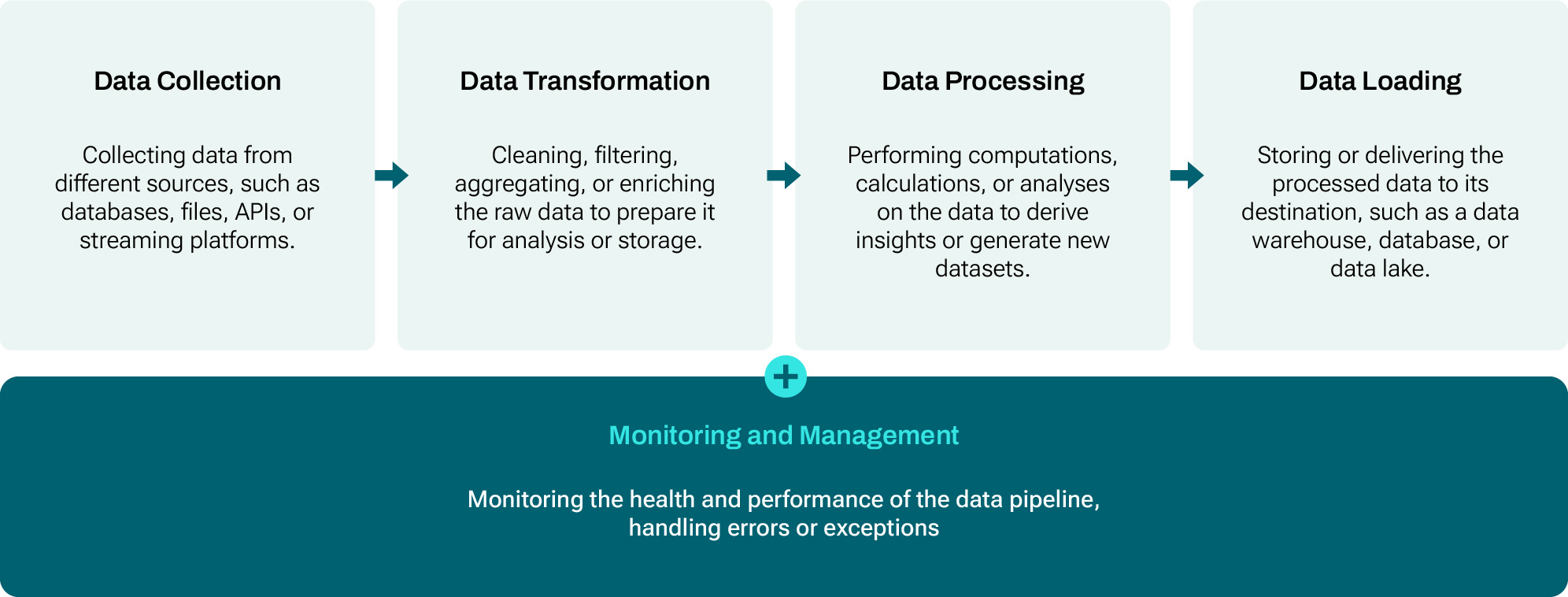Understanding the power of data management automation

In today’s data-driven landscape, businesses are constantly looking for ways to enhance their data management processes. Automation has become a crucial part of the solution, allowing organizations to efficiently manage large volumes of data, streamline workflows and deliver actionable insights to the business.
Workload automation stands at the forefront of this transformation, offering comprehensive automation capabilities across IT and business processes critical for automation of data hygiene automation, master data management, ETL workflows and more.
Intro to data management automation
Why automate the movement and analysis of data?
Data is the lifeblood of businesses. From customer insights to operational metrics, data informs strategic decisions and drives growth. However, as technology and business operations grow more complex, the sheer volume of data, complexity of data types and formats and number of data silos is overwhelming.
Managing the flow of data across an organization is therefore a continually moving target, many organizations face an unending challenge to control their data pipelines, resolve problems and mitigate risks. It has become critical to manage data pipelines in a cohesive way.
Running data pipelines using scripts and “paper” based process management is error-prone and time-consuming, those errors and longer time to execute and resolve issues can lead to delayed or misinformed decisions and missed opportunities.
If you recognize any of the things in this list, you may benefit from a more end-to-end automation approach.
- Data movement, archiving and other tasks are often:
- Managed in the individual data system.
- Performed manually by an engineer or administrator.
- Multiple automation tools are in play, with niche or narrow use cases.
- Different scripting languages and skills are involved in tasks within the data pipeline.
- Leadership often discovers flaws in data analysis, when it’s too late.
- It’s often difficult to clearly articulate what went wrong until very late in troubleshooting.
Automating data management processes addresses these challenges by combining the different tasks, technologies and “human-in-the-loop” activities into a single end-to-end managed and monitored process – ensuring data accuracy, consistency, and availability in real-time.
This approach reduces manual intervention, minimizes errors and accelerates time-to-insight, empowering businesses to make faster – more effective – data-driven decisions.
The growing need for automation in data management
As businesses expand, so do their data requirements. Traditional data management methods no longer keep pace with the increasing volume, velocity, and variety of data. Organizations need solutions that can scale effortlessly, adapt to changing needs, and integrate seamlessly with existing systems.
As we’ve touched on above, enterprise data management can often be expressed as a “pipeline” – in other words a step of tasks which together refine and activate data. These pipelines can be interdependent, managing the same data but managing different stages or directions across an organization.

The flexible and multi-use case nature of enterprise workload automation solutions means they are ideally suited to meeting the challenges of modern data management with a minimum of barriers to automation:
- End-to-end automation of workflows with:
- Platform and technology agnostic workflow design and execution
- Capabilities that bridge the gap between IT and business automation so teams can automate
- IT service management features and integrations which drive faster service delivery and problem resolution
- Controls and reporting for versioning, change management, auditing and performance
- Monitoring, alerting and controls to manage failures and provide actionable insights to administrators
Importantly these tools support connectivity across traditional architectures – such as on-premises – to the latest SaaS apps, allowing teams to build workflows which map to the flow of data while managing dependencies and errors:
- Manage data collection from enterprise storage, business solutions and productivity apps
- Provisioning resources when needed in data analytics cloud services
- Manage analysis and automation in other systems, such as data lakes and ETL tools
- Initiate and manage data analytics and reporting
- Communicate with users and consumers of data

We recommend RunMyJobs for enterprise data management automation
This is where data management automation solutions like RunMyJobs come into play, providing the scalability and flexibility needed to handle modern data demands.
ETL automation with RunMyJobs
Extract, Transform, Load (ETL) processes are the backbone of data management, enabling the movement and transformation of data from various sources into a centralized data warehouse. RunMyJobs excels in automating ETL workflows, ensuring that data flows and is processed efficiently and accurately. By automating these critical processes, RunMyJobs reduces manual intervention, minimizes errors, and accelerates data processing times, allowing businesses to maintain up-to-date data for analysis and decision-making.
Data warehouse automation with RunMyJobs
Data warehouses are central repositories of integrated data from multiple sources, essential for reporting and analysis. Automating data warehouse management with RunMyJobs involves automating data loading, indexing, and maintenance tasks, ensuring that data is always ready for use. This automation enhances the reliability and performance of data warehouses, providing businesses with timely and accurate data for strategic insights. RunMyJobs’ robust automation capabilities ensure that data warehouses operate seamlessly, supporting the dynamic needs of modern enterprises.
Real-world applications
RunMyJobs has been successfully implemented across various industries, bringing predictability and reliability to the data pipeline:
- Retail: Automating inventory management and customer data analysis to optimize supply chain operations and enhance customer experiences.
- Healthcare: Streamlining patient data integration and analysis to improve patient care and operational efficiency.
- Finance: Enhancing fraud detection and compliance reporting by automating data workflows and real-time monitoring.
Key features of RunMyJobs
- Seamless integration: RunMyJobs integrates effortlessly via Connectors with a variety of data tools and platforms such as Databricks, Boomi, Informatica Cloud, and Snowflake. This integration capability ensures that businesses can automate their data workflows across different environments without hassle.
- Real-time monitoring and error handling: With RunMyJobs, businesses can monitor their data pipeline orchestrations in real-time. This helps quickly identify and resolve bottlenecks, ensuring that data processes run smoothly and efficiently. The automated error handling mechanisms further enhance the reliability of data workflows.
- Predictive SLA management and monitoring: Build your existing service level agreements into RunMyJobs with SLA Monitoring. SLAs are monitored based on rules you define with dashboards that provide rapid access to workflow configurations and controls to manage alerting and response to potentially missed SLAs based on predictive analytics using machine learning trained on previous automation performance.
- Automated scheduling and execution: RunMyJobs excels in automating the scheduling and execution of data pipeline tasks. This eliminates the need for manual scheduling, ensuring that data tasks are executed at the right times, improving overall operational efficiency.
- Scalability and flexibility: Designed to handle growing data volumes, RunMyJobs offers the scalability needed to support long-term business growth. Its flexible architecture allows it to adapt to the evolving needs of modern enterprises, making it a future-proof solution for data management automation.
Benefits of implementing RunMyJobs
- Enhanced efficiency: By automating repetitive data management tasks, RunMyJobs significantly reduces the time and effort required for data processing. This efficiency enables IT teams to focus on more strategic initiatives, driving innovation and growth.
- Improved data quality: RunMyJobs ensures high data quality by automating data validation, cleansing, and enrichment processes. Reliable data is crucial for informed decision-making, and RunMyJobs helps ensure that businesses have access to accurate and trustworthy data.
- Faster time-to-insights: The automation capabilities of RunMyJobs accelerate the transformation of raw data into actionable insights. Businesses can quickly analyze trends, identify opportunities, and mitigate risks, gaining a competitive edge in their industry.
- Cost reduction: By optimizing operational efficiency and reducing manual interventions, RunMyJobs helps lower operational costs. Businesses can allocate resources more effectively, focusing on strategic growth areas while minimizing overhead.
Conclusion
Incorporating RunMyJobs into your data management strategy can transform how your organization handles data. From seamless integration and real-time monitoring to automated scheduling and error handling, RunMyJobs provides the tools needed to achieve efficient, reliable, and scalable data management. Embrace the power of data management automation with RunMyJobs and unlock new possibilities for your business.
Discover more about how RunMyJobs can transform your data management processes.
About The Author

Dan Pitman
Dan Pitman is a Senior Product Marketing Manager for RunMyJobs by Redwood. His 25-year technology career has spanned roles in development, service delivery, enterprise architecture and data center and cloud management. Today, Dan focuses his expertise and experience on enabling Redwood’s teams and customers to understand how organizations can get the most from their technology investments.
